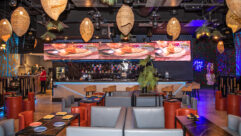The DJ’s Unique Needs
Oct 1, 2002 12:00 PM,
Nathaniel Hecht
When thinking about permanently installed sound-reinforcement systems, most contractors think about live-music performance venues using conventional mixing console technology, large front-of-house speaker systems, monitor systems, and lots of mic and line inputs. Although some of those elements make up the well-tempered music playback system, live-music and playback systems have some distinct differences. Being familiar with those differences and distinguishing between the DJ as performer and the DJ as record spinner will help a great deal in the proper design and implementation of playback systems for clubs.
CONES VERSUS HORNS
In terms of the business end of the system (that is, the speaker system) there is little difference between the technologies used in most small- to medium-size club systems. The main controversy seems to center around the subjective use of cones or horns in the midrange. Compression driver/horn combinations offer efficiency, high output, and somewhat controllable coverage patterns for midrange frequencies, which are important attributes for a well-functioning sound system in any application.
For live-sound reproduction in which vocals are involved, compression driver/horn combinations for the midrange are the norm because of the extra output requirements of the voice in terms of output and focus when competing for volume with other instruments in most combo or band applications. However, it is widely accepted among most listeners that cone speakers in the midrange are often less harsh and more pleasing to the ear for recorded-music playback. More often than not, venue size, output level requirements, and acoustical issues dictate which of the two kinds of midrange component will be the best choice.
Many horn design variations that sound quite natural have become commercially available, and in larger spaces, the driver/horn is the optimum choice purely because of economics and ease of serviceability. The reality one faces with the use of cones in the midrange is that many more of them are required to attain the equivalent sound output of the compression driver/horn combination. The additional cost is involved not just for the larger number of cone components, electronics, and amplifiers used to control and power them.
When you figure in the costs of failures and troubleshooting large numbers of systems — as well as potential downtime — choosing cone midrange components for larger systems could prove to be costly. The important part of this controversy is to always check with those who are most sensitive to the issue of midrange sound: the owner, the facility’s musical director, or the chief DJ who will be responsible for the sound.
SUBWOOFERS
Subwoofers are the most often abused part of the typical music playback system. There are dozens of reasons for woofer abuse, with the “bigger is better” mentality being the main culprit. Although in some clubs space is at a premium and woofers are flown or buried under a stage, other clubs enjoy placing them right out on the dance floor, literally creating a wall of sound. They certainly look impressive — for most clubs, looks are important — but overdoing it can cause all kinds of problems, ranging from product failure and vandalism to muddy, awful sound. To understand how this situation can get out of control, it is important to understand what it is about bass that these people want. DJs desire something simple: deep and loud bass that will rattle your insides.
The bass is critical for most dance music. Bass moves people to get up and dance, and the impact of low frequency creates the excitement on the dance floor and often throughout the entire building. As can be expected, generating bass with multiple coupled subwoofers can create all kinds of vibrationally related problems such as structure-borne noise. It can disturb neighbors at great distances away from the club because of its long wavelengths. Before caving in to the emotional needs of your client and his or her minions, check into the local noise codes and the venue’s neighborhood to avoid getting into trouble with the authorities.
Many clubs are located in industrial or other dark and dank areas of town as a result of just those problems. Can you get good solid, snappy bass without all those subwoofers? Absolutely, and in many cases, you can save your client a great deal of money. Make your client aware that he or she can live with a conventional number of subwoofers when they are properly coupled with good placement in the club. If the client feels that the visual impact is more important and specifically requests the huge subwoofer treatment, then he or she will go down that path knowing the legal and economic consequences. Some clubs choose to do it both ways, with dummy subwoofers around the dance floor for a visual effect. If you offer that option, make sure the client understands that the subwoofers won’t be operational. You don’t want to be accused of fraud.
ELF ENHANCEMENT
Want to get into trouble fast? Allow a DJ to have access to any major low-frequency adjustment device such as a graphic equalizer or subsonic enhancer. Although graphic equalizers and enhancers have become widely used in clubs, overloading the subwoofers with too much low end is a real danger. Unrestrained low frequency can cause burned voice coils from overexcursion of the woofer. Also, if the amplifiers don’t have an adequate amount of reserve output power, the voice coil can be damaged by clipped waveforms. Those can be costly mistakes that can rapidly take out a system, so make sure the limits of the system are tested carefully and under controlled circumstances. Always use a security cover or software-controllable equalizer so as not to tempt the DJ.
The product offerings in DJ mixing boards have increased substantially during the past decade or so, mirroring the rise of the creative DJ and unique performance scratch techniques. Battle boards were simple two-phono-input channel-strip mixers with a single crossfader and were designed for scratch DJ competitions. Although not all DJs use scratch techniques, the popularity of the style has permeated the club scene. As such, these smaller, no-frills mixers must be considered for inclusion in any DJ club equipment list.
KNOBS OR FADERS?
There are many mixers with many features designed for the DJ system, but the major dichotomy seems to be in the choice between knobs or faders. The first mixers used for music playback applications had rotary knobs for the control features, and those models date back to the early Bozak and Bogen designs. The rotary controls on those mixers were long lasting because they were protected from grit and dust that can get into faders and eventually ruin them. Rotary knobs are still used and favored by many music mixers — a testament to their design. UREI picked up where Bozak left off in producing the now legendary model 1620 mixer, which was an industry standard for many years before it was discontinued.
Remarkably, the 1620 never really had a working crossfader. Crossfades were accomplished by adept use of two volume potentiometers simultaneously, a cumbersome process that didn’t deter from the mixer’s popularity. Rane now builds a mixer, the MP 2016, that is reminiscent of the UREI 1620. Other companies have made and continue to make other rotary mixers, but the UREI 1620 still commands a huge following and remains highly sought after. It commands a high price on auction Web sites and through used-equipment dealers.
The advantage of faders is their smooth transition operation in crossfading between two program sources, just about the most important part of the mixer. The faders’ resistance to dirt and grime has improved, and many are quite easily replaced, even while the mixer is still powered up between discs while on the job. The majority of mixers sold today for DJ use do have faders, but it is still important to make sure that a rotary mixer isn’t required. Often designers use both, inserting the scratch mixer into the effects loop or line input stage of spare channels on the larger mixer. There is the danger of preamp level line noise when the signal is boosted again at the input stage of the receiving mixer, so care must be maintained to adjust or pad levels so as not to overload the inputs to the preamp.
Mixers vary with price and features as with most products, but the mid- to high-end mixers have multiple channels that are often selectable between mic, line, and phono so they can be custom configured to suit the needs of the DJ. Higher-priced mixers have more professional features — such as overload indicator lights on each channel, 100 mm high-quality faders, onboard effects, and modular channel strips for easy customizing and servicing — and have low noise and high-quality output specs.
However, you get what you pay for. There are still plenty of substandard mixers out there, so read the specs before deciding on a purchase. Some developments in the DJ mixer market are the new generation of matching mixer and disc players. Although it isn’t a new concept for a manufacturer to build matching sets of mixers and disc players, what is new are the cross compatibility and control features that are set up in a control link between the two devices. This development brings more control over the medium than was previously available, allowing new and more creative possibilities.
CDS OR TABLES?
How about both? Any good club system design will have turntables for phonograph records and disc players for CD material; you can’t avoid having both. Although it is true that many DJs cart around their whole mixing system, which often includes turntables and a mixer, there will be just as many who will have only their program material, and they will need to use the equipment at the club. CD players for DJ use have become quite advanced with special suspension systems to avoid skipping and vibration problems, and many have sampling loop options and unique scratch effect capabilities as onboard features. Although many DJs still prefer the use of turntables because of the hands-on feel and physical performance quality of vinyl against the slip mat, DJ-oriented CD players actually offer advantages and functions that go beyond the turntables they were designed to replace. Most DJs work with both, but for the old schoolers and the scratch DJs, only the turntable will do. Probably the most famous turntable in the business is the Technics 1200. The 1200 is the standard by which all others are measured and has certainly become legendary, but it is definitely not the only choice out there. Many new turntable designs outperform the 1200 in terms of startup speed, serviceability, features, as well as price.
Probably the most important parts of the turntable are the needle and cartridge, so it is always vital to protect those delicate parts at all costs. Because cartridges are easily damaged, keep spares in stock at the club for quick replacement when necessary. A product called Finalscratch by Stanton Magnetics has managed to morph the concept of manually scratch mixing on vinyl while using digital files on a portable computer. That development may be the first example of a shift in the artistry involved in scratch mixing by using advanced technology — just when you thought you had it all figured out.
HEADPHONES
Headphones are a necessary part of any good DJ setup. Without them it would be impossible to cue up the next song when using turntables, and it would also be impossible to preview tracks on a CD player. Everyone prefers a certain style of headphones; some prefer the Walkman-style lightweight models, and others prefer the heavy sound isolation style. Headphones, like needles and cartridges, have a tendency to walk off the job, as well, so accounting for those items after every show is a good idea (or you’ll watch the replacement costs skyrocket). Provide a good set of well-respected, on-the-ear style headphones for in-house use and a good locking connector so that they can’t be removed.
BEATBOXES AND SYNTHESIZERS
As the market has become more sophisticated, a number of formerly production-oriented tools and musical instruments have been favored by the DJ mixing community to add a bit of immediacy and groove to the recorded music. Some of those devices are inserted into the effects loop on the console, some are placed in the channel path, and some are returned to a fader on the console itself for being controlled more effectively in the mix. The DJ market single-handedly created a new market for some of the venerable old drum machines out there, namely the Roland 808 and 909, the LinnDrum, and the E-mu Drumulator. Syncing up a drum machine with the beat of the music and adding additional drum patterns has become a great enhancement to the sound and has become an industry standard.
Older analog synthesizers have also made a big comeback in the clubs. Those can all be acquired at considerable expense through used-equipment dealers and auction Web sites. Overwhelming demand and a desire to avoid these expensive methods have spurred many software and hardware products that reproduce the favorite analog (and some digital) sounds of the older devices. Other outboard effects that are used in DJ applications include standard live-sound and production recording techniques, ranging from reverbs and delays to harmonizers as well as other triggerable and dynamically tunable devices that can be used in performance or played like an instrument while mixing.
The scope of those devices is far too large to be addressed adequately in this article, but it is important to note that everyone has a favorite. Consult with the client and the DJ in charge of the systems in order to get their recommendations. For budget-conscious designers, it is possible to find devices that will do effects, sampling, and drum sounds all in one product, but those are most always going to be compromises when it comes to features and sound quality.
PASS THE MIC
Many DJ mixers have mounting flanges on the console itself that are threaded to accept a gooseneck microphone for the DJ to use to announce songs or to talk to the audience, or it can be used for other clandestine uses in the creative process. The gooseneck has been a standard for years in the DJ market, but these days anything goes, so check out the needs of the club owner and house DJ. A good suggestion is a highly directional wired handheld mic if the DJ likes to step out of the booth area, a wireless handheld or lapel mic, or even a standmounted hanging mic if the style or the booth space calls for it. Don’t forget that for parties and multiple DJ setups, it might be necessary to have more than one mic available. If the budget calls for it, a frequency agile wireless system is the most versatile mic to use.
Careful attention to the needs of the client and the house DJ is vital to the success of your club system design. Doing your homework in advance about the needs of the owner and the house DJ will give you valuable information in the design process. Another good way to find out what works is to visit some of the local clubs to see what the other contractors are doing. Ask the owner if he or she knows of a club with a similar sound and features.
The final system design will need to be tested and put through its paces. This ringing out of the system is an important step, and you should make sure to be there and observe any abnormalities with the system. If something comes up or needs to be tweaked, you’ll be around to make sure things run smoothly.
Often there will be room equalization issues, adjustments to the speaker system placement, or gain stage issues that need to be adjusted. However, the job doesn’t end there. Provide a carefully written guide for servicing the system that also contains the manuals, brochures, and other materials for all the gear. Keep a copy for yourself in your files just in case the client loses it or you need it for problem solving.
Lastly, consider selling the club a regular service agreement for the system to make sure it continues to run properly. Sometimes systems designers and contractors offer a one-year warranty before a service agreement kicks in, but that might backfire, because most of the major problems that will occur are likely to happen within the first year of use. Be careful about your time in this case; it can become all consuming when a club goes down in the middle of the night, and you have to get out of bed to fix it.
Nathaniel Hecht is editor of S&VC.










